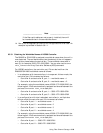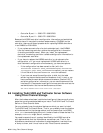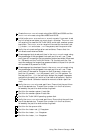to each of those devices. For example, to boot from storage unit D1 as
presented by the HSG80 controller, the AlphaServer console requires a
device name such as dga133.1002.0.1.0 that identifies the storage unit.
In addition, dga133.1002.0.1.0 must be reachable via a valid Fibre
Channel connection.
This section describes how to perform the following tasks:
• Configure HSG80 storagesets — In this document, example storagesets
are configured for both Tru64 UNIX and TruCluster Server on Fibre
Channel storage. Modify the storage configuration to meet your needs
(Section 6.6.1.1).
• Set a user defined identifier (UDID) for each storage unit — Although
Tru64 UNIX does not use this identifier directly, you use the UDID
as input to the wwidmgr -quickset command in a subsequent step
(Section 6.6.1.2).
• Use the UDID as input to the wwidmgr -quickset command to set the
device unit number — The device unit number is a subset of the device
name (as shown in a show device display). For example, in the device
name DKA100.1001.0.1.0, the device unit number is 100 (DKA100).
The Fibre Channel worldwide name (often referred to as the worldwide
ID or WWID) is too long (64 bits) to be used as the device unit number.
Therefore, you set a device unit number that is an alias for the Fibre
Channel worldwide name (Section 6.6.1.3).
• Display available Fibre Channel boot devices — When you set the
device unit number, you also set the wwid
n and Nn console environment
variables. These variables indicate which Fibre channel devices the
console can access and which HSG80 ports can be used to access the
devices. The wwidn variables also show which devices are displayed by
the show dev console command, indicating that the devices can be used
for booting or dumping (Section 6.6.1.4).
• Set the bootdef_dev console environment variable — Before you
install the operating system (or cluster software), you must set the
bootdef_dev console environment variable to ensure that you boot from
the correct disk over a reachable path (Section 6.6.1.5).
• Install the Tru64 UNIX operating system (Section 6.6.2).
• Determine the /dev/disk/dskn value to use for cluster disks
(Section 6.6.3).
• Label the disks to be used to create the cluster (Section 6.6.4).
• Install TruCluster Server software and create the first cluster member
(Section 6.6.5).
Using Fibre Channel Storage 6–35


















